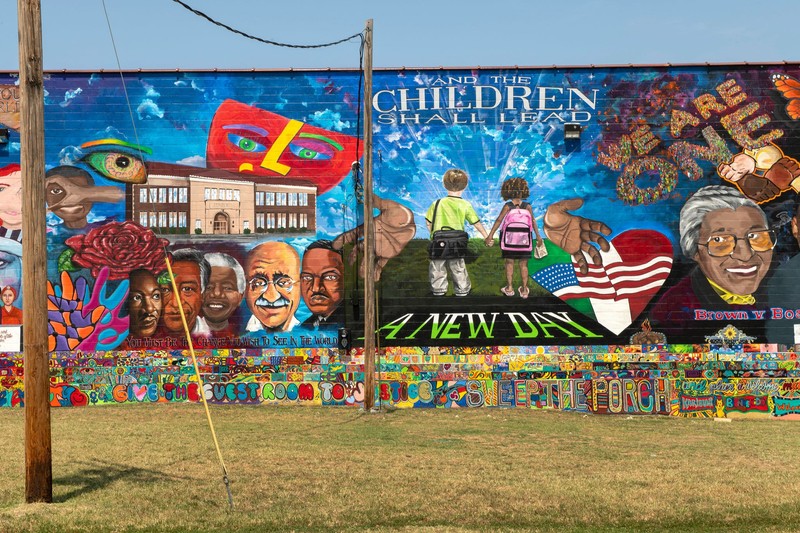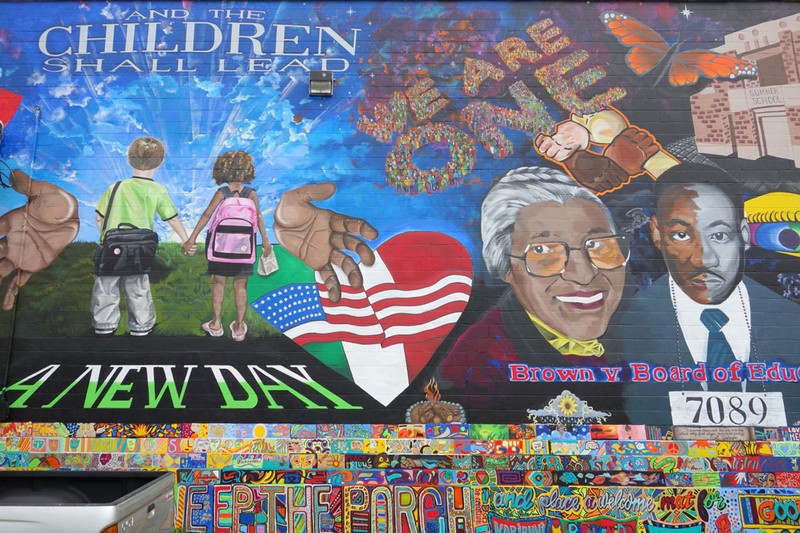Brown v. Board Mural
Introduction
Text-to-speech Audio
Across the street from the Brown v. Board of Education National Historic Site is a new mural to commemorate the landmark Supreme Court case which ruled racial segregation in public schools unconstitutional. The mural, brilliant and colorful, depicts themes of diversity, equality, and justice through the eyes of a new generation.
Images


Backstory and Context
Text-to-speech Audio
The Brown v. Board mural sits across the street from the Brown v. Board of Education National Historic Site and commemorates the landmark Supreme Court case which ruled racial segregation in public schools unconstitutional.
The idea for the mural was first conceived by Sarah Fizell, executive director of ARTSConnect, a Topeka non-profit that develops programs and activities to support the creation of art. Fizell shared her idea with National Historic Site and Michael Toombs, a Kansas City based artist and art educator. The mural was a collaborative work, spearheaded Toombs and executed by the Living Dream youth artists and community members. Larry Hill, owner of the Hill Co. plumbing supply building across the street from the historic site, donated the side of his family owned business for the project.
Eye-catching motifs painted in brilliant colors permeate the large 130' x 30' wall. Toward the center of the mural are two small children holding hands walking toward the horizon between a pair of open hands and the phrases "And the children shall lead” and “A New Day.” Other motifs include portraits of notable figures who championed civil and human rights including Rosa Parks, Martin Luther King Jr. Gandhi, Winnie Mandela, Cesar Chavez, and Thurgood Marshall, the attorney for the plaintiff of the Brown v. Board case and later the first African-American Supreme Court Justice.
Images of two schools also appear in the mural. On the left is the Monroe Elementary School for African American Students (the school at the heart of the Brown v. Board case) and on the right is Sumner Elementary School (a school that was originally only for white students). In 1950, Linda Brown attempted to enroll at Sumner Elementary because it was closer to her home. Brown’s application, along with those of 19 other students, was rejected by the Topeka Board of Education. In 1951 the Topeka NAACP joined a national class-action lawsuit that was eventually named after Linda Brown’s father, Oliver.
Mural Team
C. Dylan Barker, Blake Benton, Hector A. Bernal, Jordan E. Brooks, Cathy Burchett, Robert Tapley Bustamante, Alessandra Chavez, Daisy Escamilla, Estefana Garcia, Xavier Gayden, Jason Hanna, Dar Hosseini, Bryan Kincade, Christina Klein-Tross, Felix Maull, B.J. McBride, Oshara Meesha, Sara Myer, Justin Newhouse, Andrea Nix, Asha Rae Slack, Timothy Steward, Michael Toombs, Chloe Thompson, Lois Visser-Ulrich, Eric Underwood, Andy Valdivia, Yesenia Villarreal, Jandy Wills, Woody Woodward, Diane Wurzer
Student Artists
Lillyan Adkins, Karlyn Bowman, Adyson Cashman, Lemi Del Real, Kate Eckert, Gavin Grady, Adriania Havens, Erica Knight, Camp LeDuc, Mackenzie Miles, Brianna Pledger, Skylar Pokphanh, Alexandria Poling, Jalec Rodriguez, Levi Shows, Alejandra Solis, Am'agyn Spencer, Hayley Woodyard
Sources
https://artstopeka.org/mural/bvb
Martin, James. Kansas City Artist Michael Toombs Spearheads New Brown v. Board of Education Mural in Topeka, September 13th, 2018. https://artstopeka.org/mural/bvb.
https://brownvboard.org
